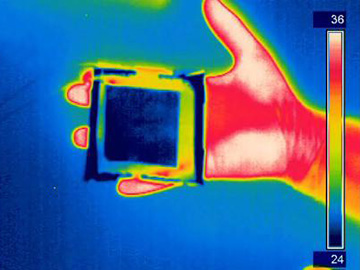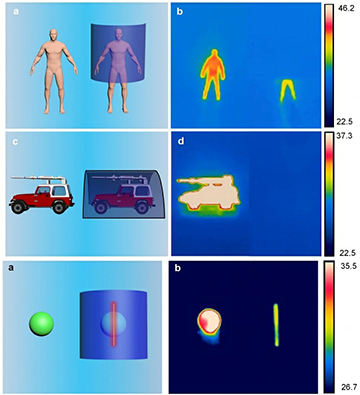
Researchers from Bilkent University and the Izmir Institute of Technology, Turkey, the Massachusetts Institute of Technology, USA, and the University of Manchester, U.K., created a thin, electrically controllable graphene-based system that can adaptively camouflage broadband IR emissions. [Image: American Chemical Society]
In recent years, research in metamaterials and other technologies has spurred progress in so-called invisibility cloaks and adaptive coloration for camouflage. But those technologies have tended to focus on the visible and UV bands, and on hiding electromagnetic energy reflected from surfaces. Concealing infrared (IR) radiation spontaneously emitted by warm bodies—the kind picked up, for example, by night-vision cameras—offers distinct and, in some ways, equally tough challenges.
In separate studies, two research groups have now proposed different routes that could lead to lightweight invisibility cloaks for broadband infrared radiation. One study uses layers of graphene, souped up with ionic liquids, to provide electrically tunable adaptive thermal camouflage. The other employs a mesh of metal-dielectric nanostructures and microscale IR emitters to create ultrathin “stealth sheets” to conceal thermal emissions. The result: Two potential new ways to fool a heat-sensing camera.
A graphene approach
Previous researchers have looked at a variety of techniques for dynamically controlling and tuning thermal emissions, including phase-change materials, electrochromic dyes and plasmonic resonators. But many of these approaches to active thermal camouflage are built on rigid platforms, or have low tunability, cover a narrow spectral band, or work too slowly for practical use.
Researchers from Turkey, the United States, and the United Kingdom, led by Coskun Kocabas of Bilkent University, Turkey, and the University of Manchester, U.K., looked at a hybrid chemical–physical system as one possible way around these problems (Nano Lett., doi: 10.1021/acs.nanolett.8b01746). Specifically, the team knew that the optical absorption of the celebrated 2-D material graphene can be tuned by so-called electrostatic gating. Such gating basically involves the doping of the material with ions that, owing to graphene’s unusual band structure, suppress optical transitions and, thus, the transmission of light, a phenomenon known as Pauli blocking.
Electrically controlled IR cloaking
The Kocabas-led team wanted to press electrostatic gating into service to create a device that could provide active thermal camouflage. To do so, they laid down multiple layers of graphene atop a porous, IR-transparent polyethylene membrane, in turn placed on top of a gold surface that acts as a rear electrode. They then impregnated the polyethylene membrane with a nonvolatile ionic liquid (that is, an electrolyte). The entire device is less than 50 microns thick, with a weight of around 30 g/m2.
When a voltage bias is applied between the gold and the graphene, ions from the liquid seep into the interstices between the graphene layers, boosting the charge density and suppressing the graphene’s IR absorption—and, thus, its IR emissivity as well. The team was able to show that, under a bias of 3 V, the device completely shut down the emission of thermal radiation from a human hand behind the screen (see image above). The effect kicks in rapidly, with a response time of less than a second after the voltage bias is applied. And, by attaching the device to a thermocouple, the team was able to set up an adaptive camouflage system, with the device responding dynamically to changes in the temperature of the underlying object.
The result, according to the researchers, is a “thin, light and flexible” device that “could easily wrap around everyday objects” to hide IR emissions. The team’s tests suggest that the device can provide adaptive camouflage across the full infrared spectrum, under a range of temperature and pressure conditions. Thus, in addition to camouflage, the researchers see applications for the technique in adaptive IR optics and adaptive heat shields for satellites in space.
A nanomaterial “stealth sheet”

The thin “stealth sheets” from the University of Wisconsin, USA, use a nanostructured surface to hide objects such as humans and vehicles. Microscale IR emitters in a separate layer can even be used to present a false thermal pattern to an IR camera. [Images: Hongrui Jiang]
A research team led by OSA member Hongrui Jiang at the University of Wisconsin, Madison (USA) took a different approach to fooling IR cameras (Adv. Eng. Mater., doi: 10.1002/adem.201800038). The team reasoned that a material consisting of carefully designed, advanced composite nanostructures to manage IR emissions would constitute the best route toward a lightweight invisibility cloak for thermal radiation. The result of their work is a lightweight IR “stealth sheet” that the researchers say can absorb and scatter IR radiation to reduce emissions to less than 5 percent, across a wavelength band from 2.5 to 15.5 microns.
The stealth sheet begins with two flexible polyimide substrates, bonded together and separated by patterned air channels. One layer includes a forest of 12-micron-long silicon nanowires and embedded silver nanoparticles. The other layer is embedded with microscale IR emitters. The nanowires, which have quasi-random diameters and orientations, significantly scatter the thermal IR wavefront, and the thermal energy is shunted down and transferred out of the device via the air channels between the polyimide layers. The IR micro-emitters, meanwhile, can be used, if desired, to present false thermal patterns to further fool a snooping IR camera.
Turning a tank into a guardrail
Jiang’s team tested the stealth sheet, which is less than 1 mm thick, with a human model and a model vehicle, both hot with thermal radiation. In both cases, the stealth sheet made the thermal radiation essentially undetectable (see image). Further, in another experiment using the embedded microemitters, the team was able to make a ball look, to a thermal camera, like a bar.
“You can intentionally deceive an infrared detector by presenting a false heat signature,” Jiang said in a press release accompanying the work. “It could conceal a tank by presenting what looks like a simple highway guardrail.”
The team is now working to scale up the stealth sheet for such real-world applications, working toward better bendability, active cooling, and feedback mechanisms to support adaptive IR camouflage. The researchers believe that the technique, coupled with other efforts in visible-light cloaking and microwave stealth materials, could ultimately “realize an all-encompassing invisibility method” that can hide all detectable electromagnetic signatures.
